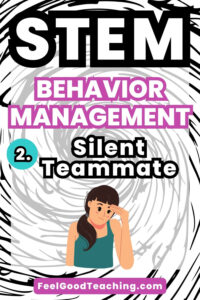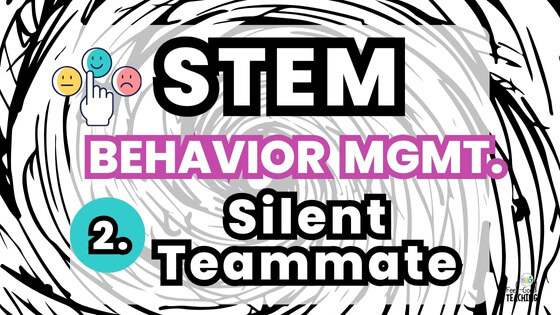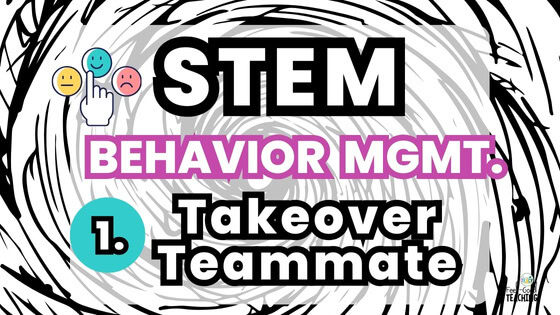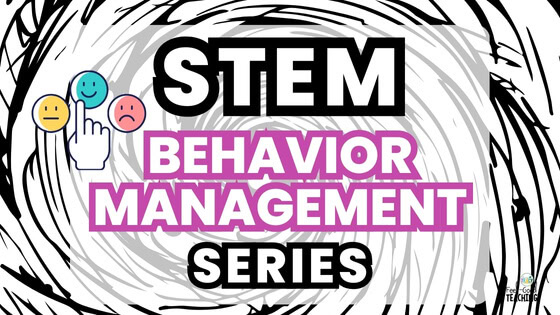Welcome back to the STEM Classroom Management Blog Series! In our last post, we talked about how to support students who tend to dominate group work. (Missed that one? Read The Takeover Teammate post here.)
This time, we’re focusing on the opposite challenge: The student who wants to participate but struggles to find their voice in a group.
Let’s talk about The Silent Teammate and how to help them find their voice.
Whether you’re dealing with off-task teams, reluctant contributors, or students who want to run the show, you’ll find teacher-tested strategies for building teamwork, critical thinking, communication, and creativity.
Meet the Silent Teammate
Every STEM educator knows this student: they’re present but not really participating. While the rest of the team debates, builds, and experiments, this kid might:
- Sit quietly on the sidelines
- Nod along but rarely speak up
- Avoid eye contact or hesitate to grab materials
- Passively agree with everything but never take the lead
This isn’t laziness. Most often, it’s a mix of social hesitation, fear of being wrong, and not knowing how to jump in. Left unaddressed, though, these students miss valuable opportunities to build confidence and collaboration skills.
Why Students Go Silent During STEM Challenges
This isn’t laziness. Most often, it’s a mix of social hesitation, fear of being wrong, and not knowing how to jump in. Left unaddressed, though, these students miss valuable opportunities to build confidence and collaboration skills.
1. Social hesitation
Worried about judgment or “messing up.”
2. Lack of confidence
They may not believe their ideas are good enough to share.
3. Dominant teammates
If one group member always takes over, others may not feel like they have space to participate. (If this is the issue, check out the Takeover Teammate post as well.)
4. Unclear expectations
If students don’t know how they’re expected to contribute, they may sit back and observe instead.
5. Processing time
Some students simply need more time to think before sharing.
The goal isn’t to push them into constant speaking. It’s to create predictable, low-pressure entry points that help them practice participating.
Strategies for Supporting the Silent Teammate
Just like the Takeover Teammate, the Silent Teammate benefits most from strategies that are proactive, inclusive, and low-pressure.
Let’s talk about what to do before, during, and after the challenge to create a more balanced group dynamic.
🌍 Before the Challenge: Lower the Barriers
⭐️ Use solo sketching or planning time first. Before launching into team discussion, give students 2–5 minutes to brainstorm, sketch, or jot down their own ideas independently. This gives everyone, especially quieter students, a chance to think without social pressure.
⭐️ Assign specific roles that create entry points. Sometimes silence comes from not knowing how to jump in. Assigning roles can help. For quiet students, consider roles like:
- Question Asker: Must ask the group at least 2 questions
- Sketch Artist: Draws the team’s design plan
- Materials Manager: Selects and organizes the supplies
⭐️ Teach and model participation norms. Before the activity, establish class expectations for balanced collaboration:
- Everyone gets a chance to speak
- We listen without interrupting
- Every idea is worth hearing
Use your 4 Cs Posters & Reflection Pages to define what effective communication and collaboration look like.
⭐️ Use sentence starters or scaffolds. Provide a few go-to prompts to help students speak up:
- “What if we tried…?”
- “I noticed that…”
- “Could we add…?”
⭐️ Build micro-practice opportunities. Before group work, rehearse participation in low-risk ways:
- Pair-share one idea with a partner.
- Have each student contribute one “wild” idea before any discussion starts.
- Use quick “turn-and-talk” activities to normalize speaking up.
⏱️ During the Challenge: Invite, Don’t Push
➡️ Circulate with intentional check-ins. As you walk around, listen for who’s talking (and who isn’t). Gently invite the quiet student into the discussion with:
“What are you thinking about this design?”
“Do you see anything the group might have missed from the criteria & constraints?”
“What would you add or change about the design?”
“Your team needs someone to confirm the design meets all constraints. Can you take that on?”
Avoid putting them on the spot in front of the whole group. A whispered invitation to share is more effective than a public callout.
➡️ Pair them with supportive partners. Strategically place students with classmates who are patient, encouraging, and open to collaboration. Avoid pairing with dominant personalities or high-energy cliques. A challenge like index card towers works well for partnered groups.
➡️ Offer a nonverbal contribution option. Allow students to write or draw their idea on a whiteboard or sticky note and have a teammate share it with the group. This lowers the stress while still honoring their thinking.
➡️ Keep an eye on team dynamics. If others in the group are excluding, interrupting, or ignoring the silent teammate, step in:
“Let’s pause for a minute. I want to make sure everyone’s idea is being heard.”
🔄 After the Challenge: Reflect and Reinforce
📌 Use private or low-stakes reflection tools. Instead of putting students on the spot to share aloud, let them reflect with:
- A quick exit ticket: “Did I share an idea today? What helped or got in the way?”
- A 4 Cs rubric focused on communication and collaboration
📌 Celebrate small steps. If a student who is normally silent shares even one idea, sketch, or question—name it:
“I noticed you shared your idea with your group today. That made a big impact on your design.”
📌 Check in one-on-one. After class or during a work session, ask:
“What kind of roles or situations help you feel more comfortable participating?”
Their answer might surprise you – and help you better support them next time.
🚀 Growth Takes Time
Quiet students aren’t trying to avoid learning. Many are processing deeply, waiting for the right moment, or watching how others react. With time, structure, and encouragement, they will find their voice.
And when they do? The team gets stronger.
STEM challenges are the perfect playground for practicing real-world skills. So rather than getting frustrated, use these moments as springboards for stronger teams.
💡 Want a Free STEM Classroom Management Handbook?
I’m putting together a printable copy of these strategies as well as navigating other tricky STEM behaviors perfect for keeping in your lesson planner or sharing at your next PLC or team meeting. It will be sent to every subscriber on my email list when the series is complete. Sign up below to get on the list.
✨ Next Up in the Series…
Is this not quite the issue? The Silent Teammate, The Absent Contributor, and The Apathetic Student are all part of this series. They can present similarly, but the strategies that help can be a little different, so be sure to check out all three posts to improve engagement.
Next, we’ll tackle The Disagreeing Designers: what to do when teammates clash, argue, or refuse to compromise.
Explore the full STEM Classroom Management Series here.
Looking for a STEM Challenge to Practice These Skills?
Try any of the challenges in the Year-Long Mega Bundle with 52 STEM Challenges!
For more practice on the 4 Cs of Engineering, check out this 4 Cs Resource Bundle.
Pin it. Share it. Save it.
Every student deserves to feel heard during STEM. Let’s help them speak up, one challenge at a time.




